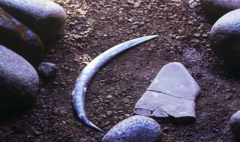Archaeologists reveal that the oldest known boomerang, aged between 39,000 and 42,000 years, was crafted from mammoth ivory, shedding light on early human ingenuity and usage.
World's Oldest Boomerang Discovered: New Insights Into Prehistoric Tool Use

World's Oldest Boomerang Discovered: New Insights Into Prehistoric Tool Use
A remarkable find in Poland challenges previous beliefs about ancient boomerangs and human craftsmanship.
The world's oldest boomerang has challenged earlier perceptions, emerging as a testament to the ingenuity of our prehistoric ancestors. Discovered in 1985 within Poland's Oblazowa Cave, this ancient tool is now estimated to be between 39,000 and 42,000 years old, surpassing initial estimates of around 30,000 years.
Crafted skillfully from mammoth tusk, this boomerang showcases remarkable craftsmanship. Although it demonstrates aerodynamic qualities to fly when thrown, it notably does not return to the thrower, indicating a primary use in hunting activities. Additionally, it raises the possibility of cultural significance, potentially serving in rituals or artistic practices.
Dr. Sahra Talamo of the University of Bologna emphasized the unparalleled insight this discovery provides into human behavior. She noted how Homo sapiens, living tens of thousands of years ago, produced such an adept tool indicates a sophisticated understanding of their environment.
Remarkably well-preserved, the boomerang displays score marks, hinting at meticulous polishing and carving tailored for a right-handed user. This find adds a new dimension to discussions on the historic use of boomerangs, which are often linked with Aboriginal cultures in Australia.
The historical context of boomerangs outside Australia is limited, but rare instances suggest their use across various continents. For perspective, the oldest known instance from Australia dates back only to about 10,500 years, while early images of boomerangs depicted in rock art are approximately 20,000 years old, according to the National Museum Australia. Further, a wooden boomerang estimated to be 7,000 years old was found in Jutland, between Denmark and Germany, along with a fragment of a 2,000-year-old oak boomerang in The Netherlands that returns upon being thrown.
This cutting-edge research, highlighting the significance of this ancient tool, has been shared in the scientific journal PLOS One and involved collaborative efforts among scientists from Poland, Italy, Germany, France, Switzerland, and the UK.
Crafted skillfully from mammoth tusk, this boomerang showcases remarkable craftsmanship. Although it demonstrates aerodynamic qualities to fly when thrown, it notably does not return to the thrower, indicating a primary use in hunting activities. Additionally, it raises the possibility of cultural significance, potentially serving in rituals or artistic practices.
Dr. Sahra Talamo of the University of Bologna emphasized the unparalleled insight this discovery provides into human behavior. She noted how Homo sapiens, living tens of thousands of years ago, produced such an adept tool indicates a sophisticated understanding of their environment.
Remarkably well-preserved, the boomerang displays score marks, hinting at meticulous polishing and carving tailored for a right-handed user. This find adds a new dimension to discussions on the historic use of boomerangs, which are often linked with Aboriginal cultures in Australia.
The historical context of boomerangs outside Australia is limited, but rare instances suggest their use across various continents. For perspective, the oldest known instance from Australia dates back only to about 10,500 years, while early images of boomerangs depicted in rock art are approximately 20,000 years old, according to the National Museum Australia. Further, a wooden boomerang estimated to be 7,000 years old was found in Jutland, between Denmark and Germany, along with a fragment of a 2,000-year-old oak boomerang in The Netherlands that returns upon being thrown.
This cutting-edge research, highlighting the significance of this ancient tool, has been shared in the scientific journal PLOS One and involved collaborative efforts among scientists from Poland, Italy, Germany, France, Switzerland, and the UK.





















